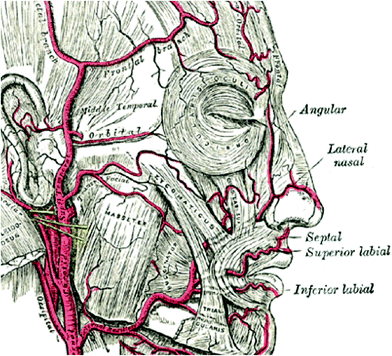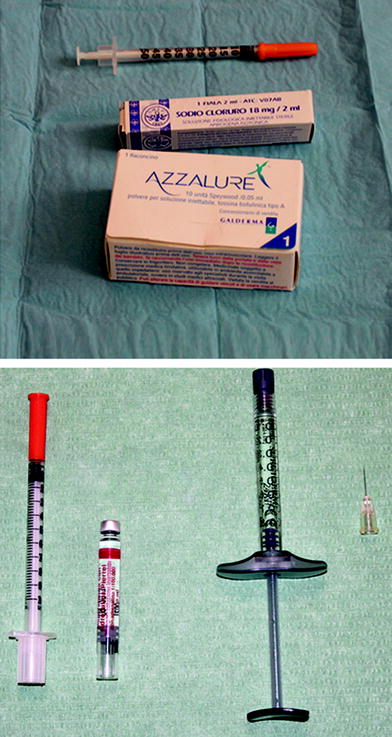Fig. 9.1
Bony part of the nose is formed by the bony nasal septum, the nasal bones, and medial parts of the maxillae, palatine, and frontal bones; cartilaginous part is formed by two lateral cartilages, two alar cartilages, and a septal cartilage. Reproduction of a lithograph plate from Gray’s anatomy (Henry Gray, Anatomy: Descriptive and Surgical)
Blood supply for nose tip and alar wings is granted by a terminal branch of angular artery named lateral nasal artery (Fig. 9.2).


Fig. 9.2
Angular artery and lateral nasal artery. Reproduction of a lithograph plate from Gray’s anatomy (Henry Gray, Anatomy: Descriptive and Surgical)
The depressor septi nasi muscle is a mimic muscle that arises from the incisive fossa of the maxilla (Fig. 9.3).


Fig. 9.3
Muscular fibers of depressor septi nasi are oriented upwards and are inserted into the nasal septum and in the back part of the alar part of nasalis muscle. Reproduction of a lithograph plate from Gray’s anatomy (Henry Gray, Anatomy: Descriptive and Surgical)
Muscular fibers of depressor septi nasi direct upward to be inserted into the nasal septum and back part of the alar part of nasalis muscle.
The depressor septi draws the ala of the nose downward.
9.2 Pitfalls
Filling with hyaluronic acid, the nasal dorsum allows the modification of the nasofrontal angle and slightly models the dorsum itself. This procedure has to be performed by injecting the filler very slowly in order to prevent arteries compression and ischemic injury.
The injections in the nasal root should be done by introducing the needle until it touches the bone and then delivering the filler just superficial to the periosteum.
Before injecting, patient’s nose profile is carefully evaluated paying attention to the nasofrontal and nasolabial angles; the right dimensions should be the following:
the nasofrontal angle: between 115° and 135°,
the dorsal angle, normally straight,
the nasolabial angle, between 90° and 110°.
9.3 Indications
Medical rhinoplasty can be employed in those cases where patients are reluctant to undergo surgery, or for correction of minor nose defects. The patients that can benefit from botulinum injections are those with a fall in the nasal tip due to hyperactivity of the depressor septi nasi.
9.4 Contraindications
Severe malformations which require surgical intervention;
Patients with recognized vasculopathies due to the terminal nature of parts of nasal irriration.
Patients who underwent surgical rhinoplasty or with a previous trauma history should be carefully evaluated before receiving any medical treatment.
9.5 Medical Rhinoplasty with Botulinum and HA
9.5.1 Operating Time
20 minutes.
9.5.2 Materials
0.4 cc of Ha medium viscosity.
Botulinum toxin type A.
Local anesthetic (lidocaine, mepivacaine) with adrenaline 1:200000 (equal to 1 mg/40 mL of solution).
30 G needle.
1 cc syringe.
Sodium chloride.
Bandages and antiseptic solution (Fig. 9.4).

Fig. 9.4
Materials for medical Rhinoplasty with botulinum and HA
9.5.3 Material Choice
Botulinum toxin | Hyaluronic acid |
|---|---|
In Europe | |
Bocouture | Surgiderm 30 XP |
Vistabex | Juvederm Ultra 4 |
Vistabel | Juvederm volift |
Azzalure | Restylane |
In Asia | |
Xeomin | Juvederm Ultra Plus XC |
Neuronox | Restylane |
Azzalure | |
Botox | |
In America | |









